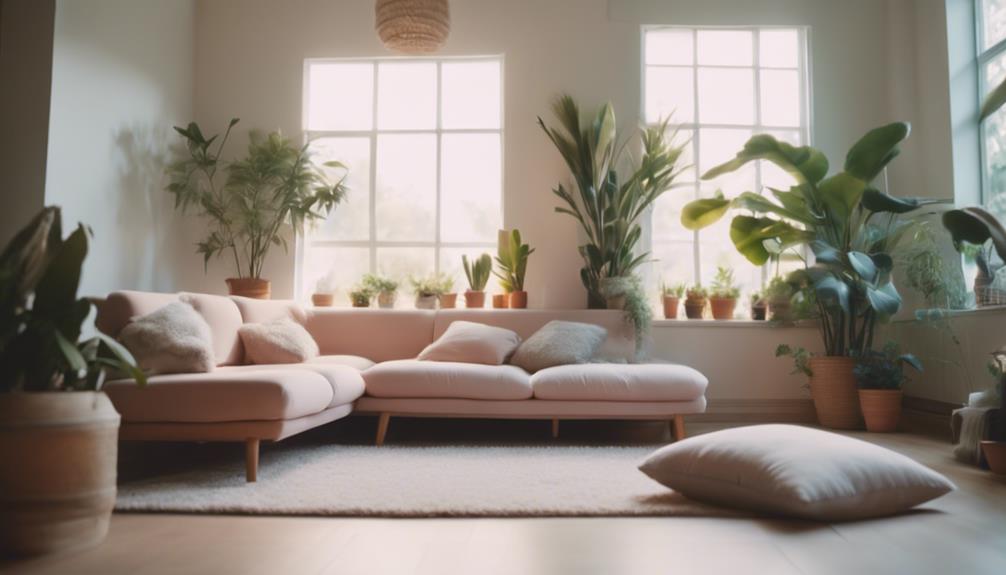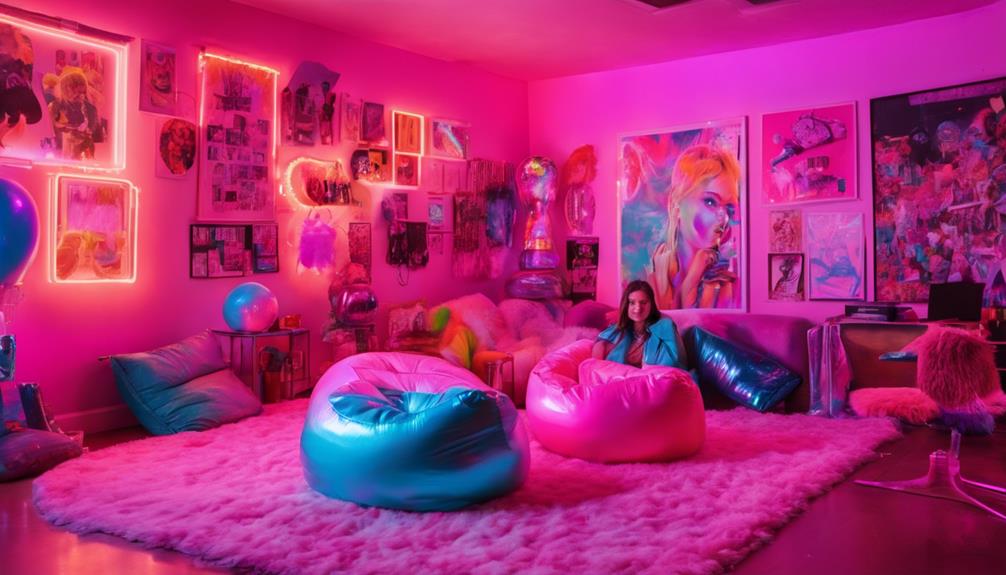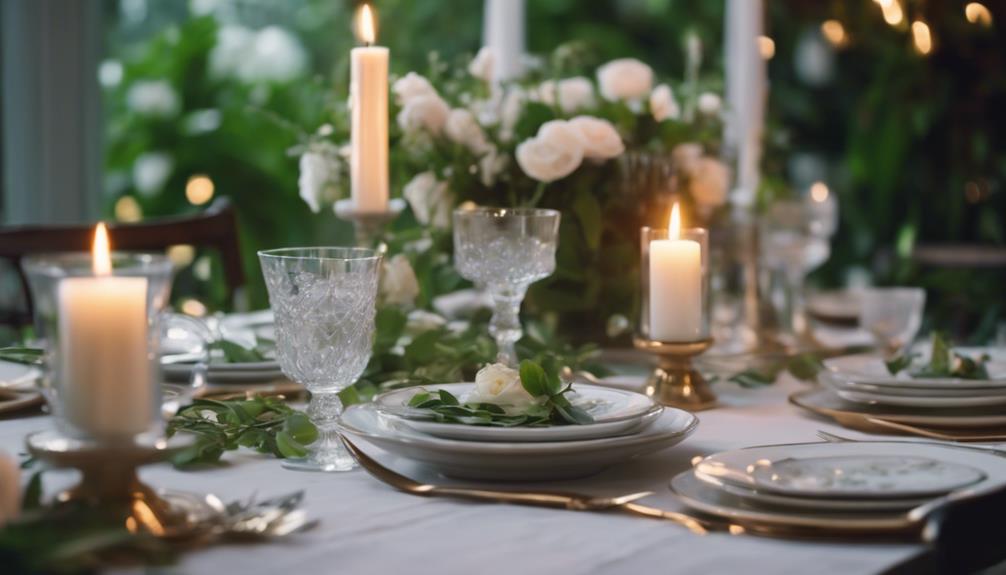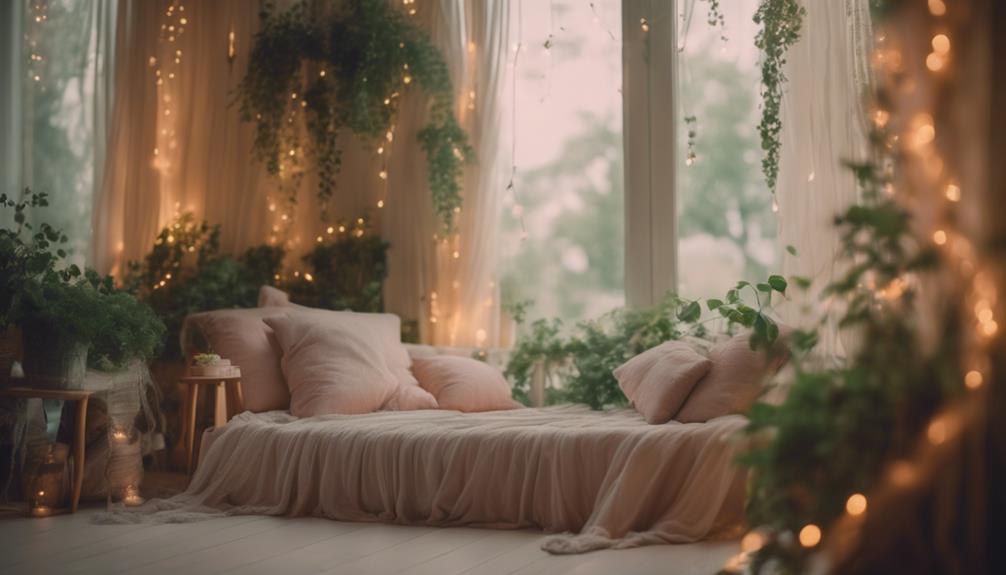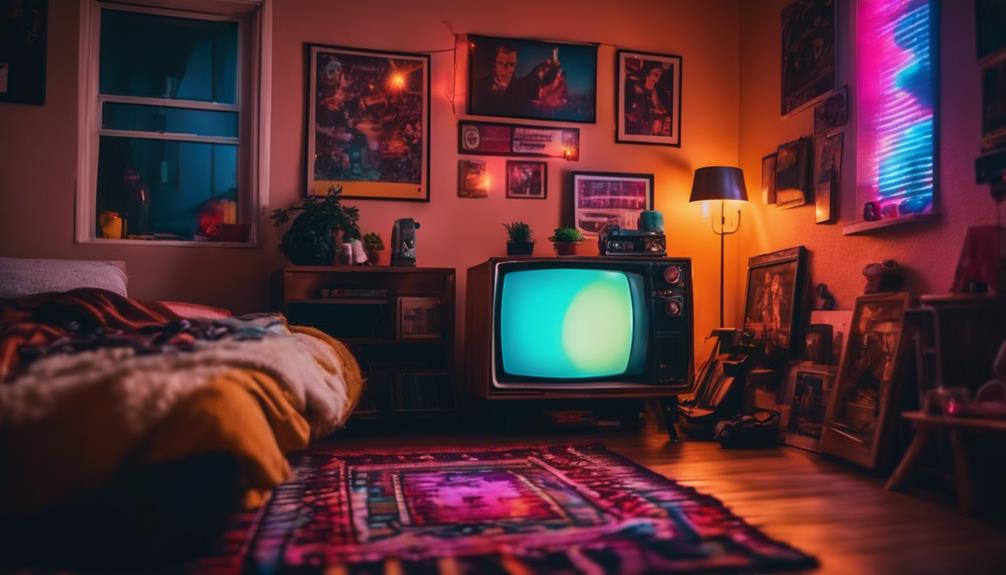To transform your space into a sanctuary, focus on calming elements that promote peace. Start with a soothing color scheme using soft blues or warm earth tones. Incorporate soft textiles like cotton bedding and plush pillows for comfort. Choose comfortable seating, such as plush armchairs, and aim for soft ambient lighting to create a cozy atmosphere. Add nature-inspired decor, like botanical wall art, to enhance tranquility. Finally, opt for natural flooring options like cork or bamboo for warmth and style. If you explore further, you'll discover even more tips to elevate your serene retreat.
Key Elements
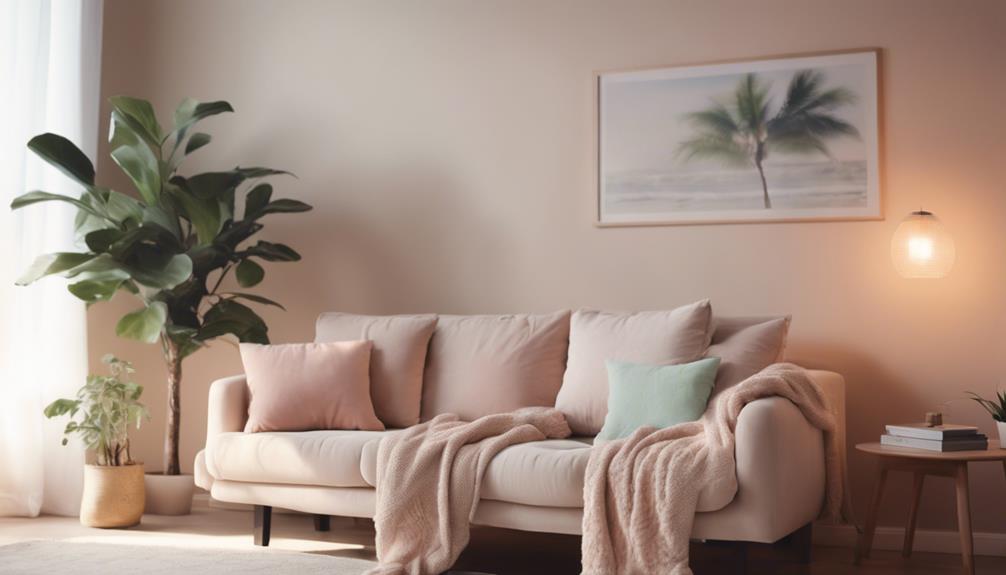
To create a peaceful space, focus on your color scheme, materials, and textures.
Choose calming colors and soft fabrics that invite relaxation and comfort.
Color Scheme
Choosing a calming color scheme with neutral tones like soft blues, greens, and warm earth tones can transform your space into a peaceful retreat. These calming hues promote tranquility and relaxation, creating an environment where you can unwind.
Incorporating muted shades in your bedding, curtains, and wall colors enhances this calming atmosphere, allowing you to feel at ease.
To elevate the soothing aesthetic, consider layering different textures within your chosen color scheme. Pair smooth linens with cozy knits to add visual interest while maintaining a cohesive look. This approach not only keeps your space visually appealing but also contributes to a serene experience.
You can introduce accent colors sparingly to inject personality into the room without overwhelming the tranquil effect of the primary color scheme. This way, you create a versatile backdrop that complements your style.
Materials
Creating a peaceful space involves selecting the right materials that enhance comfort and tranquility throughout the room. Start by incorporating soft textiles like cotton, linen, and wool. These cozy materials not only provide warmth but also help absorb sound, contributing to a serene atmosphere. Layering fabrics with throws, cushions, and rugs adds depth and visual interest, making the space feel inviting.
Next, focus on natural elements such as wood and stone in your furniture and decor. These organic materials create a sense of warmth and a connection to nature, which can greatly enhance the calming effect of your room. Quality bedding is essential, too. Invest in high-thread-count sheets and plush pillows made from breathable fabrics to guarantee a restful sleep environment that promotes relaxation.
Lastly, consider incorporating scented materials. Natural elements infused with soothing scents, like essential oil diffusers or scented sachets, can elevate your atmosphere and foster a sense of peace.
Textures
How can you enhance the comfort of your peaceful space?
Incorporating a variety of soft textures like cable knits, velvet, and suede can markedly elevate the tactile experience in your room. These materials not only feel luxurious against your skin but also promote relaxation and a sense of warmth.
Layering different textiles, such as cotton sheets, wool blankets, and plush throw pillows, adds depth and visual interest, making your space feel cozier. Don't underestimate the power of soft, floor-pooling drapes and loose slipcovers; they contribute to a calming aesthetic while inviting you to unwind.
Textiles also play an essential role in sound absorption, helping to create a tranquil atmosphere by reducing noise levels within your sanctuary.
Plus, consider seasonal changes. Swapping heavier fabrics for lighter ones can refresh your bedroom's feel and maintain a comfortable environment throughout the year.
Essential Fixtures and Furniture
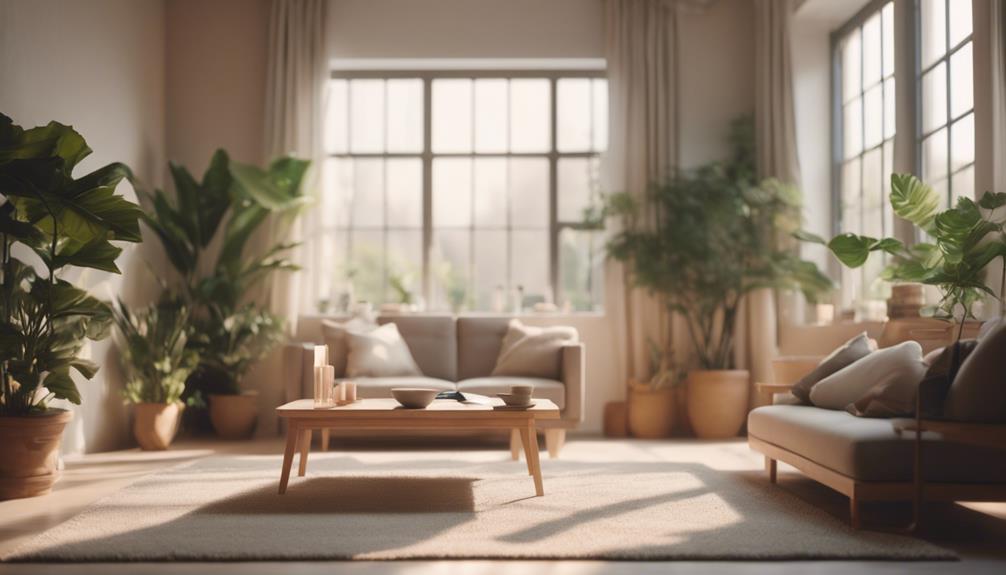
When it comes to creating a peaceful space, the right fixtures and furniture are essential.
A plush upholstered armchair invites you to relax, while soft, ambient floor lamps set the mood for unwinding.
Consider adding a hammock chair for a unique touch that encourages you to take a moment for yourself.
Plush Upholstered Armchair
A plush upholstered armchair instantly transforms your bedroom into a cozy retreat, inviting you to unwind and relax in style. This comfortable chair serves as a perfect nook for reading your favorite book or simply enjoying quiet moments.
When selecting a plush armchair, consider soft, high-quality fabrics like velvet or cotton. These materials not only enhance comfort but also add a touch of luxury to your decor. Moreover, a supportive back and cushioned seat can improve your posture and overall comfort during extended sitting sessions.
Think about how a well-placed armchair can act as a statement piece, contributing to the room's aesthetic while promoting a peaceful ambiance. Incorporating a plush upholstered armchair into your bedroom design creates an inviting space that encourages relaxation and leisure.
It's not just about adding furniture; it's about enhancing your sanctuary. With the right armchair, you're not just creating a cozy nook; you're crafting a peaceful retreat where you can escape from the hustle and bustle of daily life. Invest in a plush armchair, and you'll find it becomes an essential fixture in your journey toward a more tranquil environment.
Soft, Ambient Floor Lamps
Soft, ambient floor lamps effortlessly elevate the tranquility of your space, providing warm, adjustable lighting that invites relaxation and enhances your peaceful retreat. With their soft glow, these lamps create an environment that promotes calmness, perfect for unwinding after a long day. You can easily dim the lights to match your mood, making it easier to relax and improve your sleep quality.
Choosing floor lamps with energy-efficient LED bulbs not only helps reduce your electricity bill but also mimics the natural daylight glow, further enhancing your peaceful sanctuary. The height and design of these fixtures can define your room, allowing you to create cozy nooks for reading or meditation while adding a decorative touch to your decor.
Consider incorporating lamps made from natural materials like wood or fabric, as they contribute to a serene aesthetic and connect you with nature. Opt for models with adjustable shades or multi-directional lighting to illuminate various areas of your space. This versatility enhances functionality, ensuring your peaceful sanctuary is both beautiful and practical.
Hammock Chair for Relaxation
Hammock chairs blend comfort and style, inviting you to unwind in a cozy atmosphere that enhances your relaxation experience. These unique chairs provide a perfect spot for curling up with a book or just enjoying some quiet time.
With weight capacities ranging from 250 to 400 pounds, you can choose a hammock chair that suits your needs while ensuring safety and stability. Available in materials like cotton, polyester, and canvas, hammock chairs offer breathability and comfort, making them an excellent addition to your peaceful space.
Their versatile design allows for both indoor and outdoor use, giving you the freedom to create a serene retreat wherever you like to hang them. One of the greatest benefits of a hammock chair is its gentle rocking motion, which promotes relaxation and helps reduce stress.
Lighting Ideas

When it comes to lighting, you'll want to choose fixtures that enhance your peaceful space.
Soft string lights and warm pendant lights can create a cozy ambiance, while dimmable LED ceiling fixtures and recessed sconces let you adjust the mood.
Soft String Lights
String lights add a warm, inviting glow to your bedroom, making it the perfect retreat for relaxation and calmness. These soft string lights are an excellent way to create a relaxing bedroom atmosphere. You can easily transform your bedroom by hanging them along walls, draping them over your headboard, or even suspending them from the ceiling.
Available in various colors and styles, you can choose the ones that best complement your decor. Whether you go for a subtle white or a cozy warm hue, these lights can accentuate decor elements and define cozy nooks, enhancing your overall ambiance.
Not only do soft string lights provide a gentle light, but they also contribute to improved sleep quality by eliminating harsh overhead lighting that can disrupt your peace. Imagine winding down after a long day, surrounded by the soft glow of your favorite string lights, helping to create a serene environment.
Dimmable LED Ceiling Fixtures
Dimmable LED ceiling fixtures offer a versatile lighting solution that lets you effortlessly adjust brightness levels to create the perfect atmosphere for relaxation or any activity in your peaceful space. Whether you're winding down with a book or enjoying a cozy movie night, these fixtures help set the mood and promote relaxation.
Not only do dimmable LED fixtures save energy—consuming up to 75% less than traditional incandescent bulbs—but they also provide a cost-effective lighting option for your bedroom. Many of these fixtures are compatible with smart home systems, allowing you to control the lighting easily through mobile apps or voice commands. Imagine dimming the lights with just your voice as you transform your bedroom into a sanctuary.
Setting lower light levels in the evening signals your body to unwind, promoting better sleep quality and overall well-being. Plus, with a variety of styles and designs available, you can easily find dimmable LED ceiling fixtures that complement your bedroom decor while enhancing its tranquility.
Create that serene environment you desire, making your space a true haven for relaxation.
Warm Pendant Lights Overhead
Warm pendant lights overhead instantly create a cozy atmosphere, enhancing your bedroom's comfort and inviting relaxation. When you choose warm pendant lights, you set the stage for a relaxing bedroom sanctuary that soothes your senses. Opt for warm-toned bulbs around 2700K, as they promote calmness and reduce stress levels, making it easier to unwind after a long day.
To further enhance the ambiance, consider installing dimmable pendant lights that let you adjust the brightness according to your mood and activities. Whether you're reading a book or winding down for sleep, you can create a serene environment tailored just for you.
Varying the heights of your pendant lights adds visual interest and depth to your space, making it feel more inviting and thoughtfully designed. A stylish pendant fixture can also serve as a focal point in your room, harmoniously blending functionality with aesthetic appeal.
Incorporating warm pendant lights into your decor not only elevates the design but also transforms your bedroom into a true sanctuary, where comfort and relaxation reign supreme. Embrace the beauty of warm lighting and let it enrich your personal oasis.
Recessed Wall Sconces for Ambiance
Recessed wall sconces enhance your space with soft, ambient lighting that creates a calming atmosphere perfect for relaxation. These fixtures are versatile, allowing you to install them at various heights to direct light where you need it most, whether that's illuminating a cozy reading nook or highlighting your favorite artwork.
With energy-efficient LED options available, you can enjoy long-lasting illumination while reducing electricity consumption and costs. Dimmable recessed sconces are an excellent choice, letting you adjust the brightness to suit your mood or activity, ensuring your space remains inviting at all times.
Beyond their functional benefits, recessed wall sconces add visual interest to your sanctuary, accentuating architectural features and decor elements without the harshness of overhead lighting.
Whether you're winding down after a long day or creating a serene environment for meditation, these fixtures help you achieve that perfect calming atmosphere.
Decorative Elements
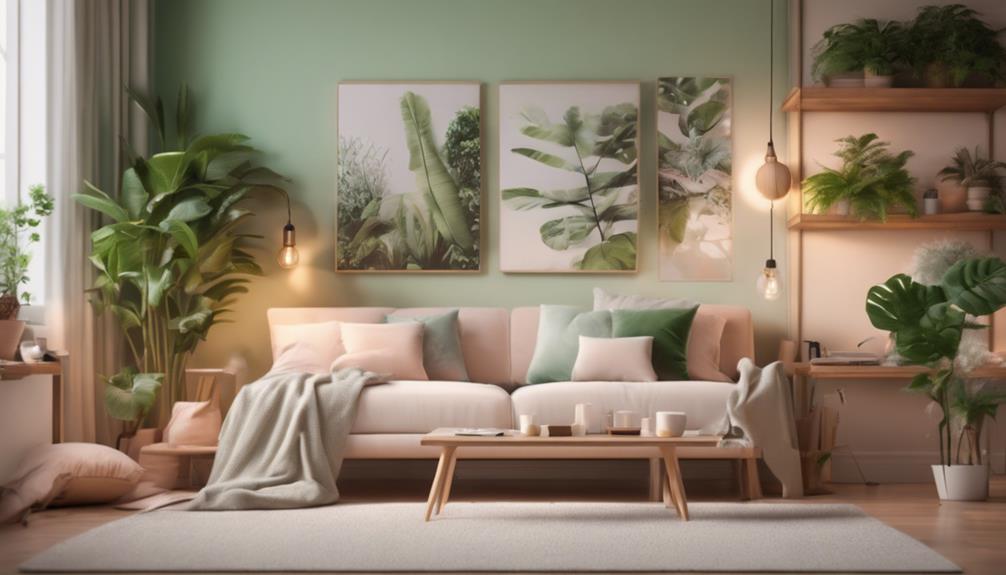
To create a peaceful space, consider incorporating decorative elements that reflect nature and simplicity.
Framed botanical wall art, a handwoven macrame wall hanging, and a ceramic vase with dried flowers can all enhance your room's tranquility.
These touches not only beautify your space but also promote a calming atmosphere.
Framed Botanical Wall Art
Framed botanical wall art brings the tranquility of nature into your home, instantly enhancing your space with its calming visuals. When you're creating a relaxing atmosphere, these prints can play an essential role. Soft colors and organic shapes in botanical designs not only soothe the eye but also align with color psychology, promoting stress reduction and a sense of peace.
By integrating framed botanical wall art into your decor, you also tap into the benefits of improved indoor air quality. Certain plants depicted in these artworks symbolize their real-life counterparts, which filter toxins and purify the air. This contributes to a healthier living environment, further supporting your quest for calm.
Consider arranging your botanical pieces in cohesive groupings to create a gallery wall effect. This method adds depth and interest to your space while keeping the ambiance serene. Displaying these prints can evoke feelings of nostalgia and connection to the outdoors, enhancing your overall well-being.
Handwoven Macrame Wall Hanging
Handwoven macrame wall hangings bring a touch of texture and warmth to your space, instantly elevating its aesthetic and creating a cozy atmosphere. These decorative elements, often crafted from natural fibers like cotton or jute, enhance the inviting feel of your room. By incorporating handwoven macrame wall hangings, you not only add visual interest but also create a unique focal point that reflects your personal style.
The intricate knots and patterns evoke a sense of calm, contributing to a peaceful ambiance in your personal retreat. As you gaze at these beautifully made pieces, you'll likely find an increase in tranquility and relaxation. They're perfect for complementing other decor while standing out in their own right.
Moreover, choosing macrame wall hangings is an eco-friendly option, as many are handcrafted using sustainable materials. This thoughtful choice aligns with creating a serene environment that's both stylish and responsible.
Whether you hang them above your bed or in a cozy reading nook, handwoven macrame wall hangings will transform your space into a true sanctuary, inviting comfort and peace into your everyday life.
Ceramic Vase With Dried Flowers
A ceramic vase filled with dried flowers brings a touch of natural beauty and warmth to your space, enhancing its serene ambiance with minimal maintenance. Unlike fresh flowers, dried flowers require no watering, making them a hassle-free option for busy lifestyles. They come in various colors and textures, allowing you to choose arrangements that complement your room's decor while promoting tranquility.
The ceramic vase serves as a stylish container that adds to the calming aesthetic of your space. Ceramics often evoke feelings of stability, grounding your decor and creating a peaceful environment. By selecting a vase that resonates with your style, you can elevate the overall look of your room.
Dried flowers also present a sustainable decor choice, reducing waste and encouraging an eco-friendly lifestyle. You can easily switch out your arrangements with the seasons, revitalizing your decor without sacrificing the peaceful atmosphere you desire. This adaptability allows you to maintain a serene space that evolves with your tastes.
Embrace the beauty of a ceramic vase with dried flowers, and transform your room into a sanctuary of relaxation and tranquility.
Flooring
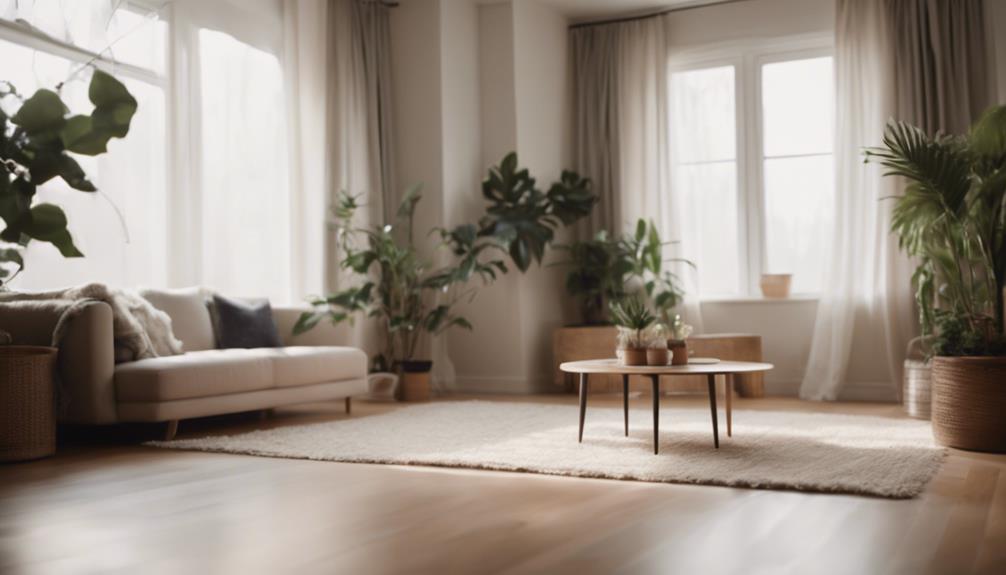
When you're choosing flooring for your peaceful space, consider options that enhance warmth and comfort.
Cork flooring offers a soft touch underfoot, while natural bamboo brings a fresh, eco-friendly vibe.
If you prefer rustic charm, reclaimed wood can add character and a cozy feel to your sanctuary.
Cork Flooring for Warmth
Cork flooring consistently offers a warm and inviting atmosphere, making it a perfect choice for creating a peaceful space in your home. Its natural insulation properties help maintain comfortable temperatures, ensuring your room feels cozy during colder months. This energy-efficient feature not only enhances your comfort but also reduces energy costs, allowing you to enjoy a calming atmosphere without worrying about high bills.
The unique cushioning effect of cork flooring adds to its appeal, providing a softer surface underfoot compared to traditional hard flooring. You'll appreciate how this comfort reduces strain on your joints, making it ideal for spaces where you spend a lot of time, like living rooms or bedrooms. Additionally, cork is naturally resistant to mold and mildew, making it a great option for allergy sufferers who want to maintain a healthy environment.
With a variety of colors and finishes available, cork flooring allows you to customize your decor while promoting a soothing vibe. Whether you prefer a modern look or something more rustic, cork flooring can seamlessly blend into your design, transforming your space into the serene sanctuary you desire.
Natural Bamboo Flooring Option
Natural bamboo flooring offers an eco-friendly and stylish alternative that enhances the tranquility of your home. As a rapidly renewable resource, bamboo can grow up to 3 feet in a single day, making it a sustainable choice that aligns with your desire for a peaceful environment. This flooring option is incredibly durable, boasting hardness comparable to oak, so it resists scratches and dents, perfect for high-traffic areas.
When you choose bamboo flooring, you'll find a variety of styles and colors to complement your decor, allowing you to create a serene space filled with natural light. Imagine walking into your bedroom and finding it transformed into an oasis, where the calming tones of bamboo ground your surroundings.
Moreover, maintaining bamboo flooring is a breeze; a damp mop is all you need to keep it clean, contributing to a healthier indoor atmosphere. Its natural hypoallergenic properties mean it won't trap dust or allergens, making it an excellent choice for those with sensitivities.
With bamboo flooring, you're not just upgrading your space — you're nurturing a sanctuary that invites relaxation and peace.
Reclaimed Wood for Rustic Charm
Reclaimed wood flooring brings rustic charm and character to your space while promoting sustainability through the repurposing of old materials. By choosing reclaimed wood, you're not just enhancing your home's aesthetic; you're also making an eco-friendly choice that reduces the demand for new timber. The unique textures and colors of reclaimed wood create a warm, inviting atmosphere, perfect for your relaxing sanctuary.
This type of flooring is often more durable than new wood, as it's already weathered environmental changes, making it less susceptible to warping and damage. Plus, installing reclaimed wood can improve indoor air quality. Many reclaimed options use non-toxic sealants, minimizing harmful chemicals that new flooring products often contain.
As you walk across the beautiful reclaimed wood, you'll appreciate that each piece carries its own history and story, adding a personal touch to your decor. This not only sparks conversation but also connects you to the past, making your space feel even more special.
Embrace the rustic charm of reclaimed wood flooring and transform your home into a peaceful retreat that reflects your values and style.
How Can I Create a Sanctuary in My Space with Relaxing Room Decor?
Transform your space and create serene room decor with calming colors, soft textures, and natural elements. Add cozy blankets, soothing candles, and peaceful artwork to make your room a sanctuary. Choose furniture that promotes relaxation and declutter to create a calming and inviting atmosphere.
Conclusion
By incorporating these key elements into your room decor, you can effortlessly create a tranquil sanctuary.
Choose essential fixtures and furniture that promote comfort, and don't forget to play with lighting to set the mood.
Add decorative elements that resonate with your personal style, and select flooring that enhances the overall ambiance.
With just a few thoughtful changes, you'll transform your space into a calming retreat where you can unwind and rejuvenate.
Enjoy your peaceful haven!
